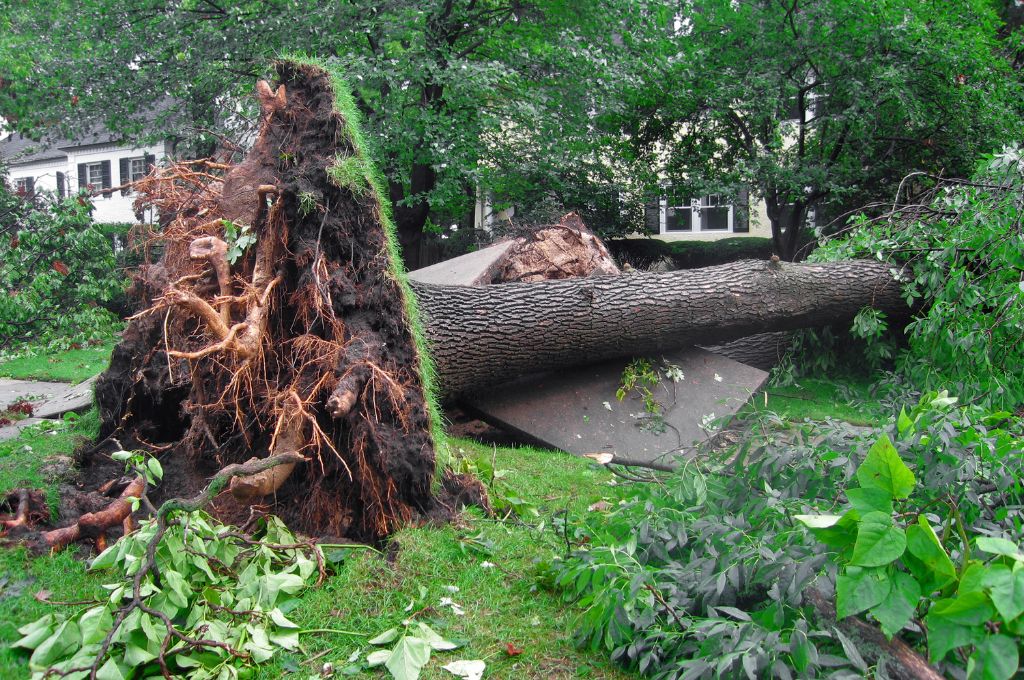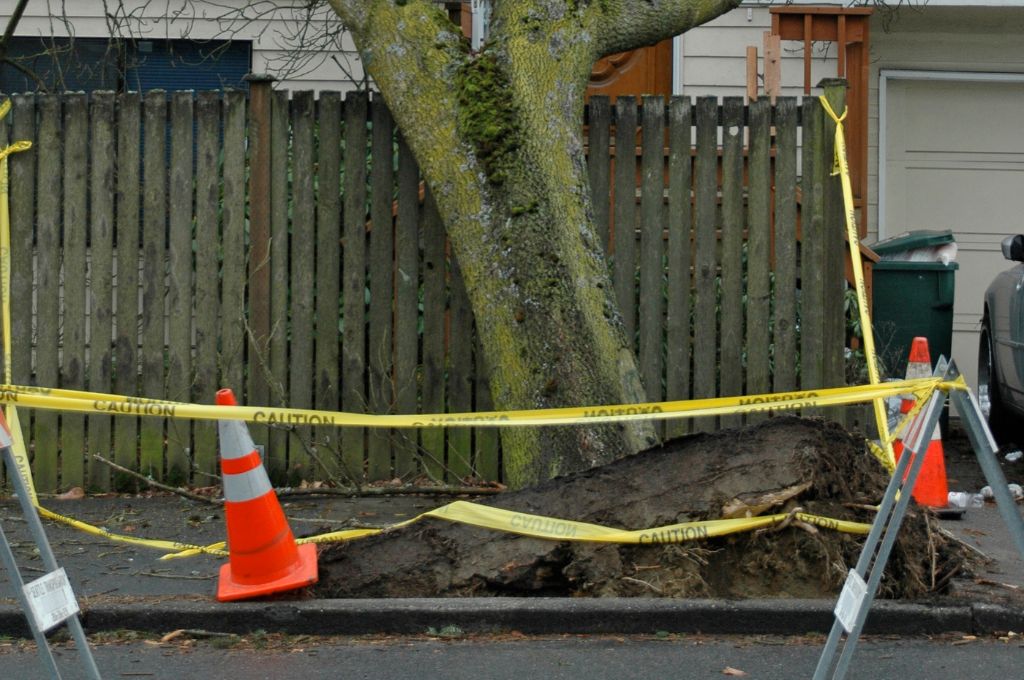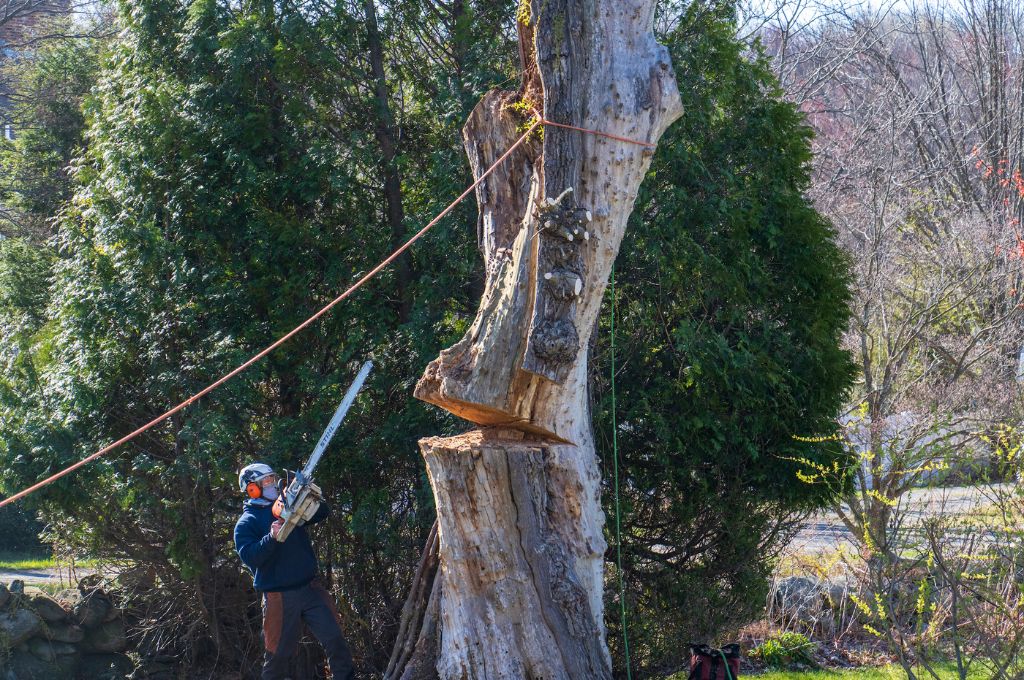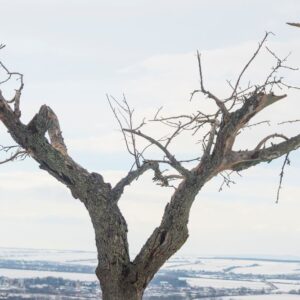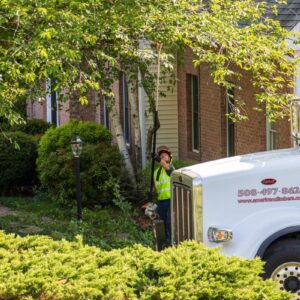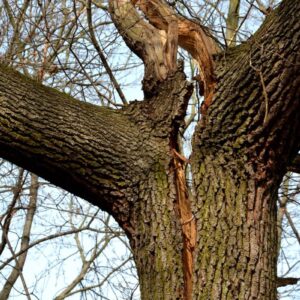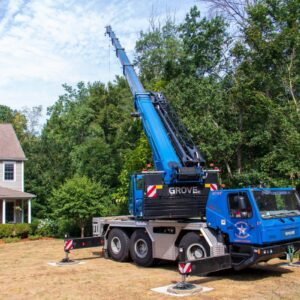Trees can come to mean a lot to us over the years, which is one of the reasons that many property owners in Massachusetts may delay removing a tree, even if it is starting to create problems.
In this article, we’ll show you some ways to identify when it is time to remove a tree from your property. However, please keep in mind that nothing replaces an inspection by a tree care professional. This article is meant to be used as a starting guide. Contact American Climbers to schedule a professional tree inspection.
Remove Trees when they are Severely Damaged by Storms
If a tree has fallen on a house or building or is blocking access, contact American Climbers immediately for our 24/7 storm damage services.
Most storm damage is immediately apparent and can be caused by strong winds, heavy snow or ice, or a lightning strike.
However, even if your tree doesn’t have limbs or branches that have fallen, there could be some large sections that have broken and could fall at any time. These limbs can cause injury or damage to buildings, people, or vehicles if they unexpectedly fall.
Additionally, a tree trunk may be in the process of splitting or branches may still crack after the storm or extreme weather has passed by. Unstable trees are of utmost concern and should be examined by a professional to assess any danger and determine if a tree needs to be removed.
Learn why storm-damaged tree removals are not a DIY project
Inspect Leaning Trees
If a tree has started to lean, it may be at risk of falling. Some trees grow with a natural lean, growing towards sunlight, for instance. But if the lean is something you’ve never noticed before, it can signal some potentially dangerous situations and a sign when you need to remove the tree.
Check for saturated soil
If the soil is very saturated from a lot of rain or flooding, the ground that holds tree roots in place may become unable to support the trees, which can lead to a tree becoming completely uprooted and toppling over. If your tree is starting to lean, it could be because of overly saturated soil, and the tree is at high risk of uprooting.
Look for cracking or heaving soil
If your leaning tree has soil that looks like it is heaving – or breaking apart and lifting up – at one side, it often means that a tree has started to fall. The roots have lifted up, and the tree is likely unstable.
Note if roots are exposed
Erosion, flooding, and construction work are some ways that tree roots can become newly exposed. If you notice tree roots that you didn’t see before, the roots may be lifting out of the ground. A professional inspection will let you know if the tree is at risk of falling and if there’s anything you can do to prevent it.
Keep an eye on top-heavy trees
If your tree has a lot of longer branches or if the tree is multi-stemmed, the heavy branches can make a tree more likely to fall, especially in the conditions mentioned above.
Check for Signs of Decay
If your tree shows any signs of decay (or rot), it means that the wood of the tree is starting to decompose. Decay is caused by fungi that can enter the tree from an open wound. Signs of decay aren’t always obvious, but there are a few things you can check for:
Fungus
Check for mushrooms at the base of the tree trunk or spores on the bark. Again, fungus usually enters the tree through open wounds, so be sure your tree is pruned properly and avoid damage from things like vehicles, lawnmowers, and pedestrians whenever possible.
Decaying roots
Roots provide water, nutrients, and oxygen to the rest of the tree, so if they start to decline, the health of your tree will also decline. Roots are also responsible for anchoring your tree in the ground, so if they are no longer steadying your tree, it is at risk of falling.
Roots are often damaged from lawn equipment, pedestrians, animals, or nearby construction. If you’ve done any recent landscaping or installed a driveway near a tree, for instance, the roots may have been damaged.
Extended periods of drought can also cause roots to die, impacting the health of the tree. Always make sure your trees are receiving enough water, especially young trees.
Other signs of decay
Other things to look for that may signal tree decay include:
- Holes in the tree or tree bark
- Peeling bark
- Sap or other substances oozing from the tree
- Wounds caused by improper pruning, storm damage, insects, woodpeckers, lawn equipment, etc.
- Dead sections of trees or leaf issues
- Sections of the tree that are soft
- Evidence of a pest infestation
Depending on the source of the decay and the level to which it has impacted your tree, the tree may need to be removed.
Remove the Wrong Tree Planted in the Wrong Place
We often emphasize planting the “right tree in the right place,” because if a tree is planted in the wrong place, it almost always needs to be removed.
Trees that outgrow the space in which they are planted is common when the mature size of the tree is not considered before planted. Trees may grow too close to buildings or other structures. The roots grow out a great distance from the tree, causing issues to sidewalks. Or maybe the tree is not suited for our climate and didn’t survive a harsh winter.
We’ve also seen trees removed because:
- The tree produced a lot of “litter” (seeds, fruit, leaves, or branches that fall to the ground)
- The tree grew too close to the power lines
- The tree blocked a view
- The tree didn’t receive the correct level of sunlight and didn’t grow correctly
- The tree is dripping sap
- The tree is creating too much shade and nothing will grow beneath it
For all these reasons and more, a tree may need to be removed.
Remove Ash Trees Infested with EAB
Emerald Ash Borer (EAB) has infested many trees in Massachusetts, leaving the trees brittle and dangerous. Unless your ash tree(s) have been successfully treated for EAB, they need to be carefully removed as soon as possible.
Remove Dead or Dying Trees
This may seem like an obvious conclusion, but many people do not know or notice that their trees are dead. Some trees might just appear to be dormant (learn how to tell the difference between dead and dormant trees here) or maybe in a section of your property where the tree is not easily visible.
Dead or dying trees can become dangerous. Limbs fall without warning, the entire tree may topple, and if the tree was killed by a pest or disease, that pest or disease can spread to other trees. If your tree is dead or dying, it is when you have to remove the tree.
Learn more about removing dead trees
Still Not Sure When to Remove a Tree? Contact American Climbers
If you are still not sure if your tree is at the point where it needs to be removed, contact American Climbers. We can inspect your tree(s) and let you know if the tree is stable, if pruning may solve any of your issues, or if we recommend that your tree should be removed.
American Climbers has the experience, equipment, knowledge, proper certification, and safety qualifications to remove your trees from even the most hard-to-reach places.
Blog Topics
Recent Posts
What's Happening? Stay Informed!
Stay on top of local events, pest and disease updates, tree and landscape tips, and more. Delivered straight to your inbox each month.

